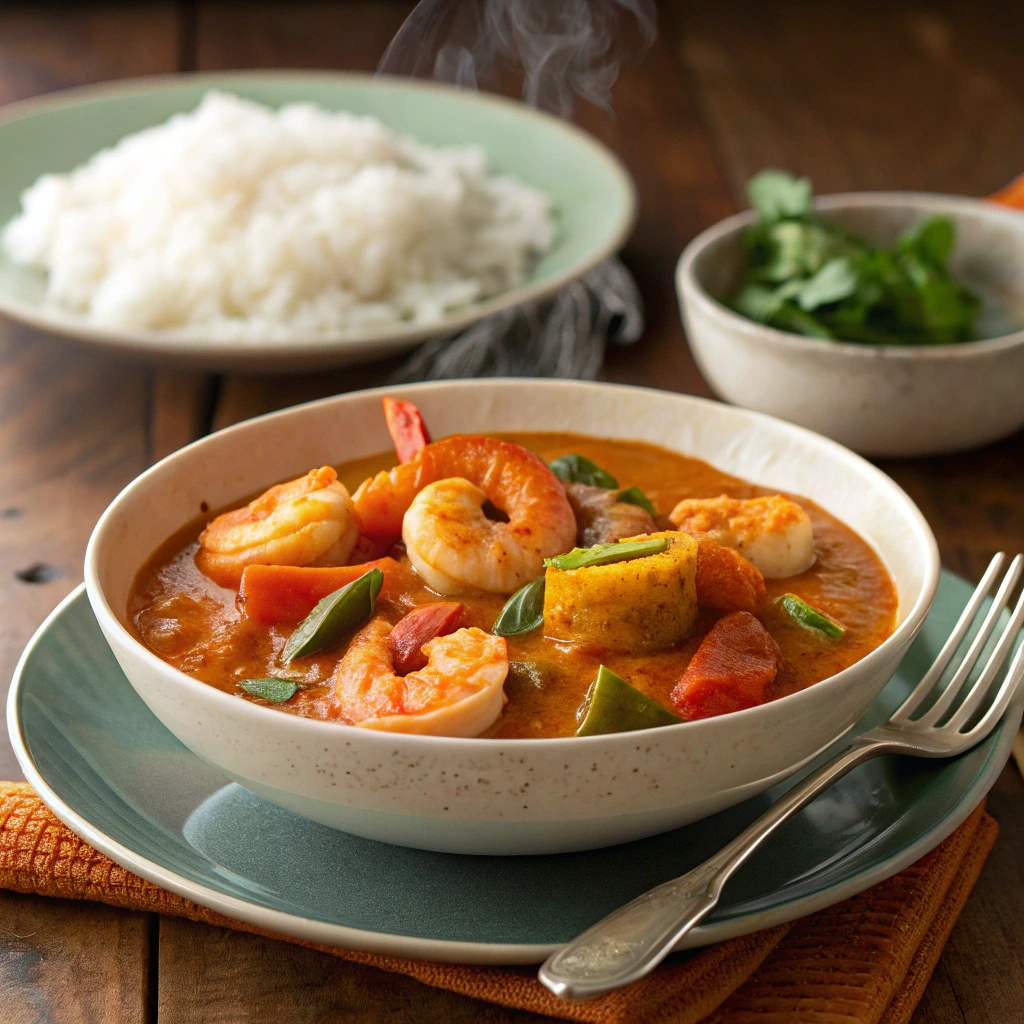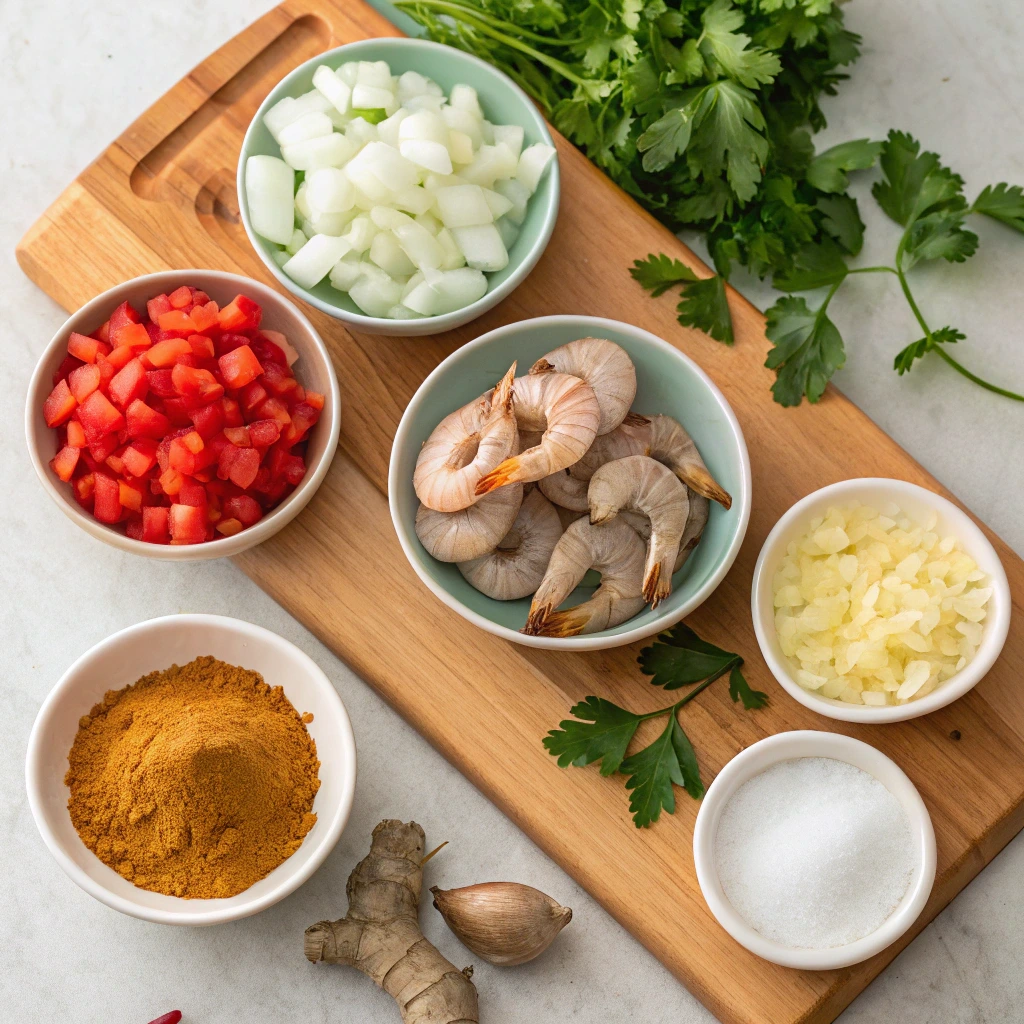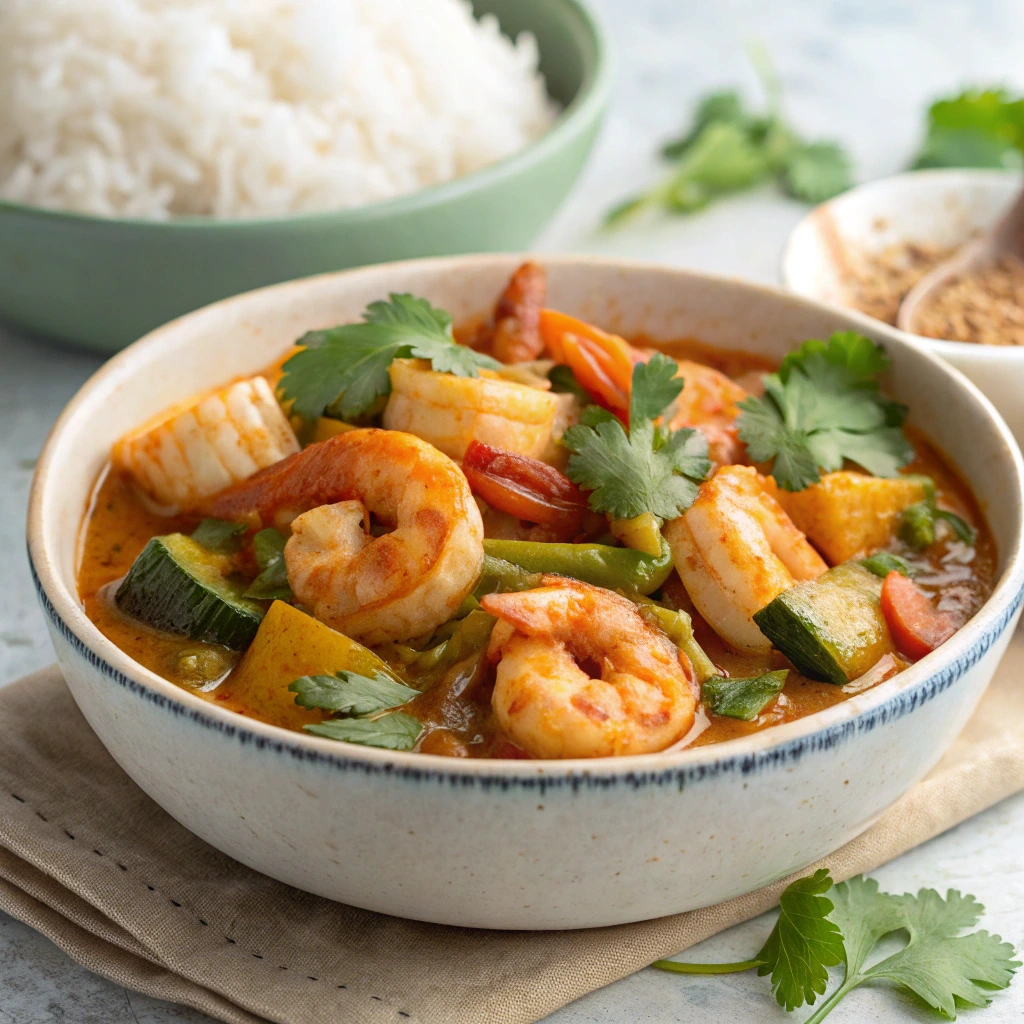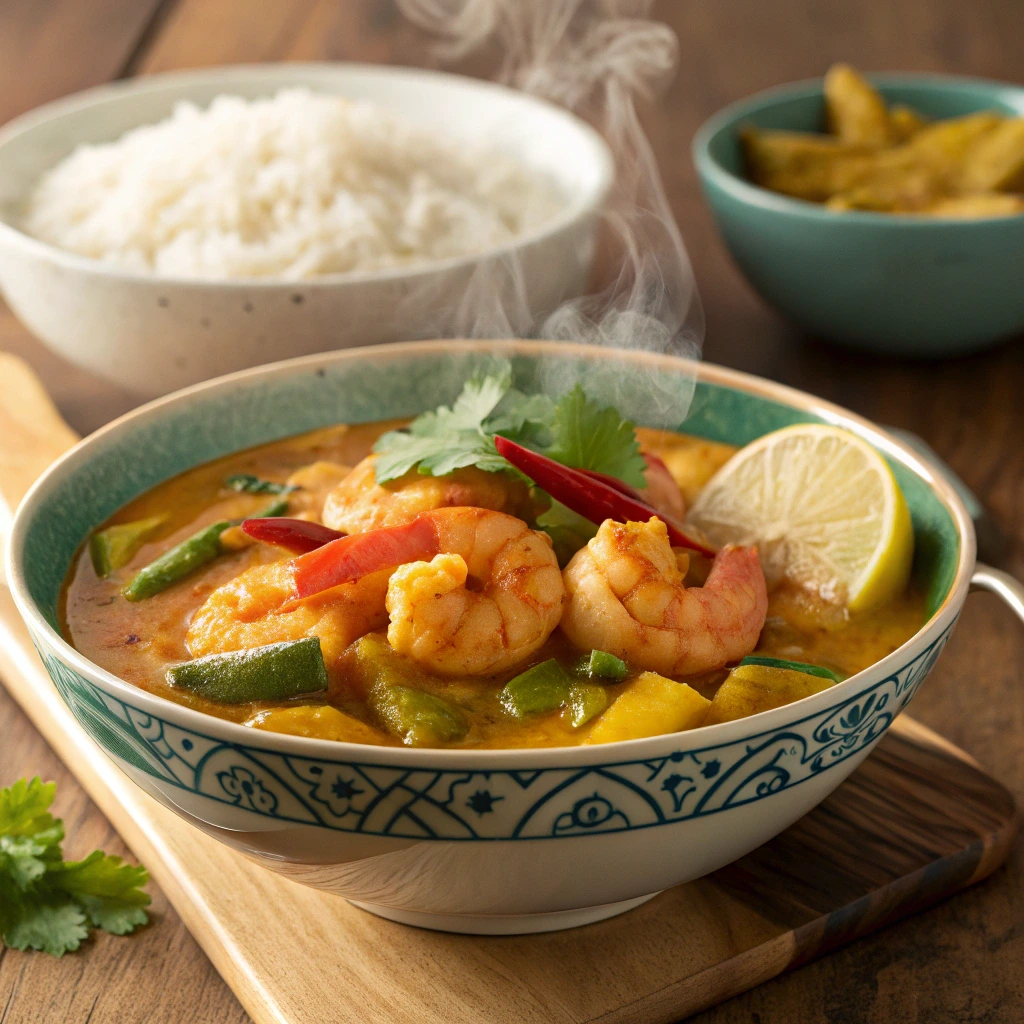How to Make Authentic Shrimp Curry at Home (Step-by-Step Guide)
There’s something magical about a steaming bowl of shrimp curry—the way the rich, fragrant sauce clings to plump, juicy shrimp, the warmth of spices dancing on your tongue, and the satisfaction of knowing you made it yourself. No need for takeout when you can create a restaurant-worthy dish in your own kitchen.
Maybe you’ve tried shrimp curry at your favorite Thai or Indian spot and wondered, “Could I make this at home?” The answer is yes—and it’s easier than you think. This guide will walk you through every step, from selecting the freshest shrimp to balancing spices for that perfect depth of flavor.
By the end, you’ll have a foolproof shrimp curry recipe that’s creamy, aromatic, and packed with bold flavors—ready in under 30 minutes. Let’s dive in!

1. What Makes This Shrimp Curry Authentic?
Not all shrimp curries are created equal. What sets this recipe apart?
Why Homemade Shrimp Curry Beats Takeout
- No hidden additives – Control exactly what goes into your curry.
- Customizable heat & flavor – Prefer it extra spicy or mild? You decide.
- Fresher ingredients – No overcooked shrimp or watered-down sauce.
Key Flavor Profiles (Spicy, Creamy, Aromatic)
- Spicy – Chili, black pepper, and ginger add warmth.
- Creamy – Coconut milk creates a luscious texture.
- Aromatic – Garlic, cumin, and turmeric build complexity.
Indian vs. Thai vs. Caribbean Shrimp Curry
| Style | Key Ingredients | Flavor Profile |
|---|---|---|
| Indian | Garam masala, tomatoes | Earthy, tangy, medium heat |
| Thai | Lemongrass, red curry paste | Bright, herbal, spicy |
| Caribbean | Allspice, Scotch bonnet | Sweet, smoky, fiery |
This recipe leans Indian-inspired but includes tips for Thai and Caribbean variations.
2. Ingredients for the Best Shrimp Curry
Quality ingredients make all the difference. Here’s what you’ll need:
The Essentials
Shrimp – 1 lb (450g), peeled & deveined (Size: 21-25 count for best texture)
Aromatics – 1 onion (diced), 3 garlic cloves (minced), 1 tbsp ginger (grated)
Spices – 1 tsp turmeric, 1 tsp cumin, 1 tsp coriander, ½ tsp chili powder
Coconut milk – 1 can (13.5 oz) full-fat (for creaminess)
Optional Add-Ins
- Bell peppers (for crunch)
- Fresh tomatoes (for acidity)
- Lime juice (for brightness)
Pro Tip: Avoid pre-cooked shrimp—they turn rubbery when simmered.

3. Step-by-Step Shrimp Curry Recipe
1: Sauté Aromatics & Spices
- Heat 2 tbsp oil in a pan over medium heat.
- Add onion, garlic, ginger—sauté until golden (3-4 mins).
- Stir in spices—toast for 30 seconds to unlock flavors.
2: Simmer with Coconut Milk
- Pour in coconut milk, scraping up browned bits.
- Simmer 5 mins until slightly thickened.
3: Add Shrimp
- Gently stir in shrimp.
- Cook 3-4 mins (just until pink and opaque).
4: Garnish & Serve
- Finish with cilantro + lime wedge.
- Pair with basmati rice or naan.
4. Pro Tips for the Perfect Shrimp Curry
Avoid Rubbery Shrimp
- Don’t overcook! Shrimp cook in 3-4 mins.
- Pat dry before adding to the curry.
Adjusting Spice Level
- Mild: Skip chili powder, use bell peppers.
- Extra hot: Add ½ tsp cayenne or fresh chilies.
Using Frozen Shrimp?
- Thaw overnight in the fridge.
- Or, place in a cold water bath (30 mins).
5. Serving Suggestions & Variations
Best Pairings
- Rice: Basmati, jasmine, or cauliflower (low-carb).
- Sides: Naan, roti, or cucumber raita.
Dietary Swaps
- Keto: Skip sugar, add extra fat (ghee or coconut cream).
- Vegan: Use tofu or chickpeas instead of shrimp.
6. The Science Behind Perfect Shrimp Curry
Why Coconut Milk Works So Well
- Contains healthy fats that carry flavor molecules
- Emulsifies spices for a smooth, velvety texture
- Balances heat from chili peppers
The Maillard Reaction in Curry Making
When you sauté aromatics:
- Onions caramelize at 320°F (160°C)
- Garlic releases allicin at 140°F (60°C)
- Spices toast best between 300-350°F (150-175°C)
Pro Tip: Use a infrared thermometer to monitor pan temperature
7. Regional Shrimp Curry Variations
South Indian Shrimp Curry
| Characteristic | Details |
|---|---|
| Base | Mustard seeds + curry leaves |
| Key Spice | Fenugreek |
| Texture | Thin, broth-like |
Bengali Chingri Malai Curry
- Uses prawns instead of shrimp
- Features poppy seed paste
- No chili – relies on black pepper for heat
8.Health Benefits of Shrimp Curry You Should Know
This flavorful dish isn’t just delicious – it’s packed with nutrients! Here’s why shrimp curry deserves a spot in your healthy eating rotation:
1. High-Quality Protein Powerhouse
- Shrimp provides 24g protein per 100g (more than chicken or beef)
- Supports muscle growth and repair (Source: USDA FoodData Central)
2. Anti-Inflammatory Superstars
- Turmeric contains curcumin, shown to reduce inflammation (NIH Study)
- Ginger may ease digestive issues (Harvard Medical School)
3. Heart-Healthy Fats
- Coconut milk contains lauric acid (may improve HDL cholesterol)
- Shrimp provides omega-3s (linked to lower heart disease risk) (American Heart Association)
4. Immunity-Boosting Compounds
- Garlic’s allicin fights bacteria and viruses (Journal of Immunology Research)
- Chili peppers’ capsaicin may enhance immunity (ScienceDirect Study)
Pro Tip: Maximize benefits by using wild-caught shrimp (higher omega-3s) and cold-pressed coconut oil (retains more nutrients).
Dietary Adaptations
| Diet | Modification |
|---|---|
| Keto | Increase healthy fats, reduce onions |
| Paleo | Use ghee instead of vegetable oil |
| Low-FODMAP | Omit garlic, use garlic-infused oil |
9. Common Mistakes & How to Fix Them
Curry Too Watery
Solutions:
- Simmer uncovered 5 more minutes
- Mix 1 tsp cornstarch with 1 tbsp cold water, stir in
- Add 2 tbsp unsweetened coconut flakes
Shrimp Tough/Rubbery
Prevention:
- Buy wild-caught shrimp (better texture)
- Cook at medium heat (not boiling)
- Remove from heat when shrimp form “C” shape

10. Advanced Flavor Building Techniques
Layering Spices
- Whole spices first (cinnamon, cardamom)
- Ground spices next (turmeric, coriander)
- Fresh aromatics last (ginger, garlic)
Umami Boosters
- 1 tsp fish sauce (even in Indian-style curry)
- 2 dried shiitake mushrooms (soaked and minced)
- 1/2 tsp marmite (secret restaurant trick)
11. Beverage Pairings
Best Matches
| Curry Style | Beverage |
|---|---|
| Thai | Riesling (off-dry) |
| Indian | Gewürztraminer |
| Caribbean | Jamaican ginger beer |
12. Historical Context
The Portuguese Influence
- Introduced chili peppers to India in 16th century
- Vindaloo originally used shrimp (not pork)
- Goa remains India’s shrimp curry capital
13. Sustainability Considerations
Choosing Eco-Friendly Shrimp
- Look for MSC-certified wild shrimp
- Avoid imported farmed shrimp (high antibiotics)
- Best options: Oregon pink shrimp or Gulf white shrimp
14. Leftover Makeovers
Next-Day Transformations
- Shrimp curry fried rice
- Curry omelet (add 2 beaten eggs)
- Stuffed paratha (wrap in flatbread)
15. Equipment Recommendations
Must-Have Tools
- Carbon steel wok (better than non-stick for curries)
- Spice grinder (for whole spices)
- Infrared thermometer (perfect spice toasting)
16. Cultural Etiquette Tips
Serving Traditions
- In Kerala, served on banana leaves
- In Thailand, always with extra lime wedges
- In Trinidad, accompanied by mango chutney
17. Time-Saving Hacks
Meal Prep Shortcuts
- Freeze spice paste in ice cube trays
- Pre-peel shrimp and store in buttermilk
- Batch cook curry base (lasts 5 days refrigerated)
18. Kids-Friendly Version
Mild & Sweet Adaptation
- Replace chili with paprika
- Add 1 tbsp honey
- Serve with coconut rice (kids love the sweetness)
19. Restaurant Secrets
Pro Chef Techniques
- Bloom spices in oil first
- Finish with butter (even in coconut milk curries)
- Use shrimp shells to make quick stock

20. Final Pro Checklist
Taste and adjust salt, acid, heat, sweetness
Let rest 5 minutes before serving
Garnish with something fresh (herbs, lime, sprouts)
FAQ Section
Can I Use Frozen Shrimp?
Yes! Thaw properly to prevent excess water in the curry.
Is Shrimp Curry Spicy?
You control the heat. Reduce chili for mild flavor.
How Long Does It Last?
3 days refrigerated. Reheat gently to avoid overcooking shrimp.
Conclusion
Now that you’ve mastered authentic shrimp curry, you’ll never settle for bland takeout again. This recipe is quick, flavorful, and endlessly customizable—perfect for weeknights or impressing guests.
Ready to try it? Grab your ingredients and let the aroma of spices fill your kitchen. Don’t forget to tag your creation #HomemadeShrimpCurry—we’d love to see your masterpiece!
Craving more? Explore our Thai green curry or butter chicken recipes next!
